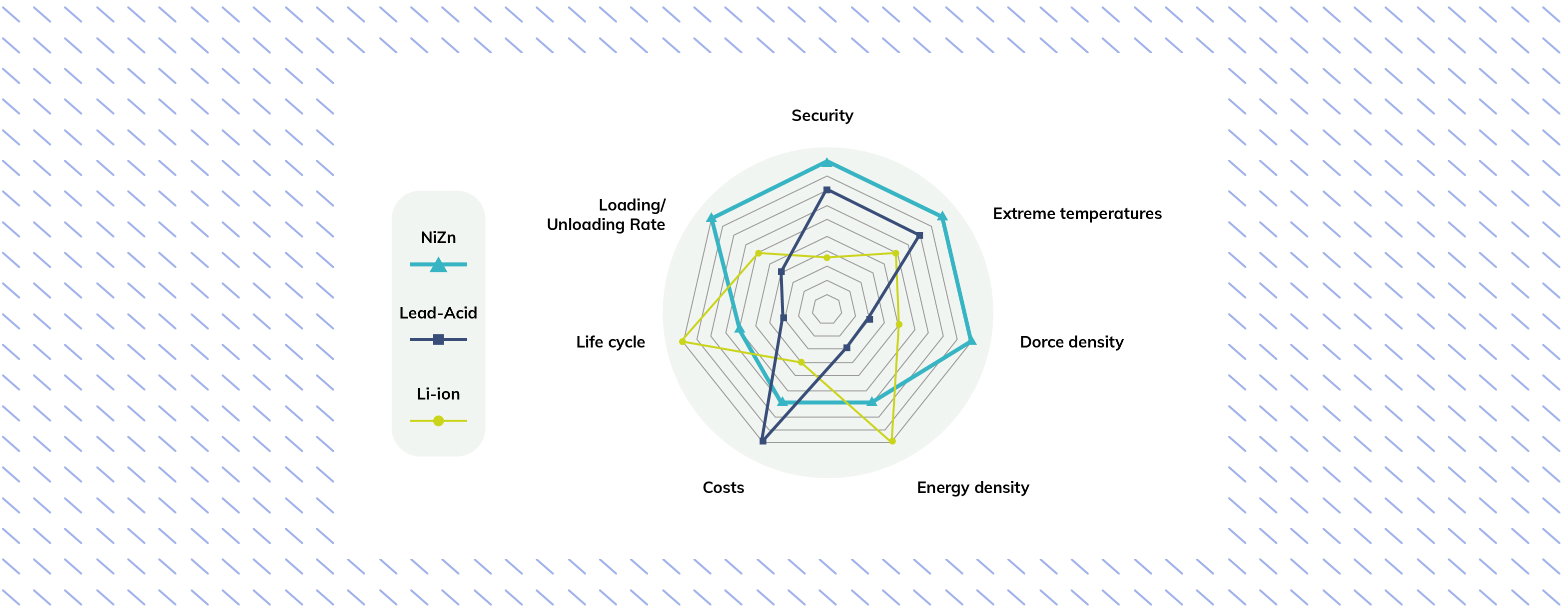Just over ten years ago, when the first modern electric vehicles arrived on the market, lithium-ion batteries allowed cars to drive about 120 km before they needed a recharge. Now there are automotive manufacturers advertising cars with an 800 km range. This example clearly shows how much battery technology has evolved, not only for cars but for various kinds of energy storage and consumption, both at an individual and industrial level, whether in connection with the electricity production sector or not.

"Many of the devices currently being installed or deployed, whether in people's homes or near wind and solar farms, use lithium batteries, which are the mainstream technology now."
André Botelho, EDP Inovação
"Many of the devices currently being installed or deployed, whether in people's homes or near wind and solar farms, use lithium batteries, which are the mainstream technology now," says André Botelho, Head of Energy Storage at EDP Inovação. Click here to enter text. He explains that lithium-ion (Li-ion) "is a technology that can be used for relatively immediate purposes, such as helping to maintain the frequency of the system, but also for longer-term purposes, such as using solar energy at night," hence its benefits and evolution. Again, according to Pablo Berruecos, the Head of Energy Storage at EDP Renováveis in North America, "batteries will remain for decades, and there continue to be advances in their chemistry - for instance, to improve their efficiency." He argues that long-term batteries will become increasingly popular, with "improvements mostly in terms of efficiency and degradation, in order to reduce costs."
The challenge of energy density
Energy-storing batteries fall into the electrochemical segment, which includes condensers and flow batteries. Lead is still used for multiple purposes, but it is losing more and more ground to Li-ion, which continues on an ascending route. Several companies are also investing in nickel-zinc (NiZn) batteries - which have been used for more than 100 years, but recent developments promise greater capacity, durability and resistance to extreme temperatures, in a smaller format. Labelec, for instance, is involved in a European project, LOLABAT, which aims to test the long-term potential of NiZn.


"At this moment, the evolution of battery storage technologies is focusing on increasing the energy density of these solutions, which affects not only performance but volume as well," says EDP NEW project manager Eduardo Ruano Rodrigues. And all this "has to be reconciled while addressing different application requirements and ensuring the commercial competitiveness of this technology, through the price of the solutions when they reach the market." Mostly because "if you think on a large scale, like large wind and photovoltaic farms, the space intended for using the primary resource may not be a technical problem, but on a smaller scale, when you transpose this to a distributed context – for instance, when using rooftops in densely populated areas – space is a restrictive factor, and the integration of storage capacity may leverage the operational extent and efficiency of decentralized production systems."

"At this moment, the evolution of battery storage technologies is focusing on increasing the energy density of these solutions."
Eduardo Ruano Rodrigues, Project Manager at EDP NEW
Even if you make a distinction between batteries for cars and other smaller-scale devices, on the one hand, and large storage projects associated with renewable energy farms, on the other, the specific uses of batteries can complement the distribution network and help manage it efficiently. "There is a growing interest in the possibility of using cars - and even other energy storage equipment - as a fail-safe solution for the grid in situations of need," says Pablo Berruecos.
EDP has long been exploring the concept of smart grids with InovGrid, which has applications in Portugal, Spain, and Brazil. EDP is also specifically testing power delivery to a home or a grid via electric cars. The pilot project 'Vehicle 2 Grid' revolves around a bidirectional flow vehicle charger which makes it possible to both charge and discharge a car battery. The growing importance of battery storage will further strengthen the resilience and 'smartness' of energy distribution networks.
Environmental concerns drive battery innovation
One of the key issues for the evolution of batteries - one that also raises criticism from certain sections of society - is the environment. Although the lifespan of batteries has been increasing steadily, the difficulties in recycling them should be a constant concern. "There are definitely some aspects of batteries that need to be worked out in order to minimize their impact on the environment," says André Botelho, "but one of the things that the European Union and other countries have been working on is recycling, which will boost the sustainability of this type of storage system."
According to André Botelho, battery recycling "will boost the sustainability of this type of storage system."
A good example is the European Battery Alliance (EBA250), a European Commission project that aims to drive the battery industry - and create a market worth €250 million by 2025 - by bringing together companies, governments, and research centers from various countries. "With electrification set to be one of the main pathways to decarbonization, batteries as electricity storage devices will become one of the key enablers of a low-carbon economy," says the European Commission on its energy storage page. EDP is one of the more than 600 organizations comprised in the EBA250 alliance, which, in seeking to create a European battery market, also encourages battery reuse or recycling.
One of the principles of the circular economy is to reuse instead of recycling, and that is precisely what EDP and LABELEC are doing with the 2Life project. Seven used electric car battery cells were connected, creating a unique system that aims to assess the performance and degradation of these batteries during their first lifetime. The objective is to test the hypothesis that EV batteries, once replaced, can have other applications - as if they were new batteries.


The effervescence of battery-related ideas and technologies can also be seen in the number of patents that have emerged in recent years. According to the International Energy Agency (IEA), more than 65,000 energy storage-related patents have been registered worldwide since 2000, namely in Japan, Korea, the European Union, the United States, and China. Between 2005 and 2018 the number of patents rose by 14% every year - four times more than in the technology industry in general.
Whether made of lithium ions, nickel-zinc or some other kind of yet to be discovered or under study agent, batteries will be in the front line of energy storage and decarbonization. According to Eduardo Rodrigues, in an electrified world, with production and consumption centered on renewable energies, "electricity storage capacity will be more and more impactful and pressing, becoming an inevitable tool for the various actors of the electric power industry."
energy storage
Storing energy for a better future
If renewable energy is one of the ways to achieve carbon neutrality, energy storage ensures its effectiveness. All so that solar and wind energy can continue to grow and so that the need for fossil fuels is ever less.
